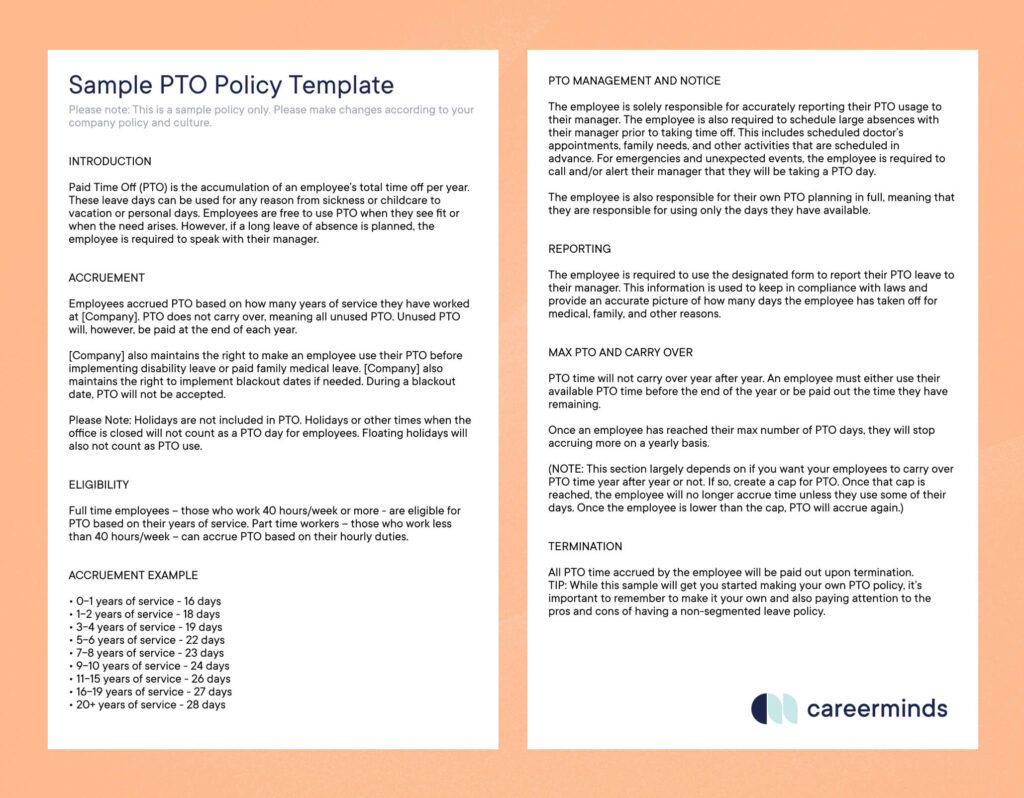
Sample PTO Policy: What You Need to Know About Paid Time Off
April 29, 2025 Written by Rafael Spuldar

Compare Providers
Download our outplacement comparison sheet
Request Pricing
Compare our rates to other providers
Creating a clear, modern paid time off policy is a business necessity. Work-life balance is a priority for today’s workforce, so the way your company handles PTO can impact everything from recruitment to retention. Whether you’re a small business or a large organization, a solid employee leave policy will help you stay competitive and support your team.
In this guide, we’ll walk you through what a sample PTO policy should include, how it differs from other types of leave, and best practices for creating and implementing your own company’s paid time off policy.
First, What Is PTO?
PTO stands for “paid time off” and is the amount of paid leave an employee has accrued while working at a given company. PTO is one of the most common discretionary benefits in the workplace.
What Is the Difference Between PTO and Vacation Time?
Understanding the distinction between PTO and vacation time will help clarify your employee leave policy. While some companies still separate leave types, many combine them into one flexible, modern PTO policy to better reflect today’s workforce needs.
- Vacation time: Traditionally, it refers to days that can be taken off for leisure or travel.
- PTO (paid time off): A consolidated bank of time that can be taken off for any purpose: vacation, illness, emergencies, personal needs, and more.
Why Use PTO Instead?
- Offers greater flexibility to employees.
- Reduces dishonesty (no need to fake a “sick day”).
- Simplifies administration for HR teams.
However, some companies still prefer segmented leave policies if they want to track how each type of time off is used (particularly for compliance purposes).
Start with a Sample PTO Policy Template
You can use our free sample PTO policy to create your own paid time off policy or evaluate your current policy to see how it stands up to the ever-changing HR landscape.
We recommend using these sample PTO guidelines as a framework to get you started, rather than the final policy you use. Your PTO policy—and pretty much every HR policy—should be intimately connected to your company culture and branding, both internally and externally.
Remember that this sample PTO policy and guide are for informational purposes only and do not constitute legal advice. Always be sure to consult your legal counsel when crafting your own paid time off policy.

What Should Be Included in a PTO Policy?
Your PTO guidelines should be clear, comprehensive, and aligned with your HR strategy. A strong paid time off policy outlines employee expectations while making administration easy for your team.
Let’s explore the key components every sample PTO policy should include:
- Eligibility requirements: Clearly define which types of employees are eligible for PTO—full-time, part-time, and/or contract workers—and outline any probationary period before accrual begins.
- Accrual structure: Explain in detail how PTO is earned over time—whether monthly, per pay period, or annually—and be specific about maximum accrual caps and carryover limitations.
- Usage guidelines: Provide a clear process for how employees can use their PTO, including how to submit requests, how far in advance to request, and any necessary manager approvals.
- Carryover and expiration: Indicate how much unused PTO can be carried over into the following year, whether there’s a use-it-or-lose-it rule, and any deadlines for using accrued time off.
- Payout at termination: To avoid legal or financial confusion, clarify whether unused PTO will be paid out when an employee leaves the company and under what conditions.
- Coordination with other leaves: Explain how PTO interacts with other types of leave, such as unpaid, family and medical leave (FMLA), or jury duty, to ensure consistency and compliance.
Creative PTO Perks That Stand Out
Creative vacation policies can be powerful employee engagement tools. By aligning your paid time off policy with your brand values, you’ll encourage healthy work-life balance and create a stronger connection between your team and your mission.
Here are some real-world examples to inspire you:
- Airbnb offers employees an annual $2,000 travel stipend to stay at Airbnb locations. This policy encourages time off while inviting employees to engage with and experience the very product they help to build.
- Netflix doesn’t have set vacation or holiday schedules, allowing employees to take time off as needed. The company states, “We don’t have a prescribed 9-to-5 workday, so we don’t have prescribed time off policies for salaried employees either.”
- Salesforce grants employees 56 hours (7 days) of paid volunteer time off (VTO) each year to dedicate to community service or other activities they care about. This strengthens company values, promotes social responsibility, and deepens employees’ sense of purpose at work.
PTO Policy Pros and Cons
Every type of paid leave or vacation policy comes with trade-offs. While a combined PTO bank offers flexibility and simplicity, it can also lead to issues if not appropriately managed. Understanding the pros and cons of your employee leave policy helps ensure that it aligns with your culture and goals.
Pros:
- Greater employee autonomy: Workers can control how they use their time.
- Easier reporting: One single PTO category simplifies tracking.
- Reduced micromanagement: Managers don’t have to question the reason for different time off requests.
Cons:
- Sick presenteeism: Employees may save their PTO for vacations and work while ill.
- Less overall time off: Some combined PTO policies offer fewer total days off than more segmented systems.
- Equity issues: Hourly vs. salaried staff may perceive fairness differently.
If you choose to move forward with a combined paid time off policy despite these potential cons, make sure that you encourage the use of PTO for all needs—not just fun ones—and educate your workforce about the value of rest and recovery.
Additional Leave Types to Consider
Many businesses offer other forms of paid time off in addition to standard PTO. Expanding your employee leave policy to include options like holidays, parental leave, or volunteer time shows that you value employee well-being and work-life balance.
Some common alternative types of paid leave include:
Parental Leave
- Should include paid maternity and paternity leave if possible.
- Involves a set eligibility and duration (e.g., 6 weeks at full pay).
Holiday Leave
- Typically offers 8 to 10 paid holidays.
- May include floating holidays for cultural or personal reasons.
Sabbatical Leave
- Is often offered to long-tenured or creative employees.
- Often 1 to 6 months in length, with full or partial pay.
Volunteer Time Off (VTO)
- Encourages more community involvement.
- Usually 1 to 2 days per year.
Can Employers Restrict the Use of PTO?
Employers are allowed to restrict PTO use within reason. Above all, they must ensure that the restrictions don’t violate local laws and are applied fairly to avoid discrimination claims. On top of that, having clear PTO guidelines helps prevent confusion and supports business continuity.
Common PTO restrictions include:
- Blackout periods: Times when PTO cannot be taken (e.g., national holidays or peak seasons).
- Minimum notice: Typically 1 to 2 weeks prior for planned leave.
- Manager approval: How all requests must be approved in advance.
- Maximum consecutive days: Policies may cap the length of extended absences.
Unlimited PTO: Yay or Nay?
Some organizations offer unlimited PTO, where employees can take as much paid time off as needed, pending approval. This model works best in cultures of high trust and accountability.
Pros:
- Removes accrual tracking: No need to calculate or monitor how much paid time off is being earned or used, simplifying administrative processes.
- Encourages trust and flexibility: Shows employees that they are trusted to manage their time responsibly, which can boost morale and engagement.
- Eliminates PTO payout at termination: Since there are no accrued days off, companies aren’t liable for these PTO payouts when someone leaves.
Cons:
- Employees may take less time off: Without defined limits, some may feel unsure about how much is acceptable, resulting in fewer breaks and a greater risk of burnout.
- Difficulty implementing fairly for hourly workers: Unlimited PTO often doesn’t translate well for non-exempt staff, creating disparities.
- Requires strong cultural support: Leadership must actively support time off or risk their employees feeling guilty or discouraged from using it.
EXPERT TIP:
If you offer unlimited PTO in your company’s paid time off policy, make sure that you lead by example. Encourage your leadership to take a healthy amount of paid time off as well.
How Do Employees Accrue PTO?
Your PTO guidelines should explain exactly how employees earn paid time off. Whether using accruals or annual allotments, a sample PTO policy helps standardize how leave is tracked and managed across your organization.
There are two common methods for earning paid time off:
Time-Based Accrual
- PTO is earned per pay period or per month.
- Example: 1.25 days per month = 15 days per year.
With this method, employees usually start accruing PTO after a specific period of time (e.g., 30 days post-hire).
Annual Allotment
- All PTO is given at the beginning of each year.
- This makes it easier to plan vacations, but may require pro-rated adjustments if an employee starts or leaves mid-year.
With a tiered annual PTO structure (like the one below), you can reward employee loyalty while providing clarity for new hires.
How Do You Create a PTO Policy for a Small Business?
Creating a PTO policy for a small business doesn’t have to be complicated. The key is balancing employee needs with business resources. A well-thought-out vacation policy helps improve morale, reduce turnover, and streamline how your team handles time off.
Here are the steps to creating a scalable PTO system in a small business:
Choose a PTO Model
You have three main choices:
- Traditional Model: Separate buckets for sick, vacation, and personal days.
- Combined PTO Bank: One bucket for all types of leave (most common).
- Unlimited PTO: Employees take time as needed, pending manager approval.
Most small businesses opt for a combined PTO model for its simplicity, but make sure to carefully evaluate all of these options to see which best aligns with your culture and business goals.
Determine Accrual vs. Annual Allotment
This aspect can potentially have a much bigger impact on small businesses. While the time-based accrual method can help with cash flow and employee turnover, the annual allotment is easier to administer. Which one you opt for will depend on what is more convenient for you to manage.
Ensure Legal Compliance
Small businesses often don’t have in-house legal teams, so reviewing local and state labor laws is crucial to ensure that your paid time off policy is compliant. If you feel unsure about doing this on your own, consult a specialized lawyer.
Document and Communicate
Some small businesses may also lack clear employee communication or documentation processes. If that’s the case, you’ll want to ensure that the paid time off policy is included in your onboarding materials and made available online for every employee.
Best Practices for PTO Policy Implementation
Once you’ve chosen a paid time off policy, implementing it correctly is crucial. The best sample PTO policy means nothing if employees don’t understand it or feel discouraged from using it.
Follow these tips to make your paid time off policy work in practice:
1. Be Transparent
- Communicate openly and early: Introduce the PTO policy during onboarding and revisit it regularly. Use multiple channels like handbooks, intranet, and town halls.
- Clarify common scenarios: Provide examples and FAQs so that employees feel confident about when and how to use their time off.
2. Ensure Consistency
- Apply uniformly across teams: Ensure that all departments follow the same rules to avoid perceived favoritism or unfairness.
- Train managers on policy details: Managers should model consistent decision-making and avoid granting exceptions inconsistently.
3. Encourage Employees
- Normalize taking time off: Publicly celebrate vacations or wellness days to reduce stigma.
- Set PTO goals: Some companies require employees to take a minimum number of days off each year to ensure that they recharge.
- Monitor burnout signals: Use surveys or HR metrics to spot any overworked staff needing a nudge to take time away.
4. Review Annually
- Collect employee feedback: Ask employees about what’s working and what needs improvement. Anonymous surveys work well for this.
- Benchmark with peers: Compare your PTO structure with industry standards to stay competitive.
- Adjust as needed: Flexibility in your policy helps ensure that it stays relevant as your business and workforce evolve.
Paid Time Off Policy: Final Thoughts
Your company’s PTO guidelines aren’t just about compliance. They’re a reflection of how much you value your team. A strong paid time off policy encourages rest, supports well-being, and helps you retain top talent.
So take the time to craft something thoughtful. Whether you’re refining an existing plan or building from a sample PTO policy, your employees (and your bottom line) will thank you.
Need a jumpstart? Download our customizable sample PTO policy below to help you craft a surefire paid time off policy that makes your company stand out while engaging, recharging, and revitalizing your staff. Start building a better approach to time off today!
In need of outplacement assistance?
At Careerminds, we care about people first. That’s why we offer personalized talent management solutions for every level at lower costs, globally.



